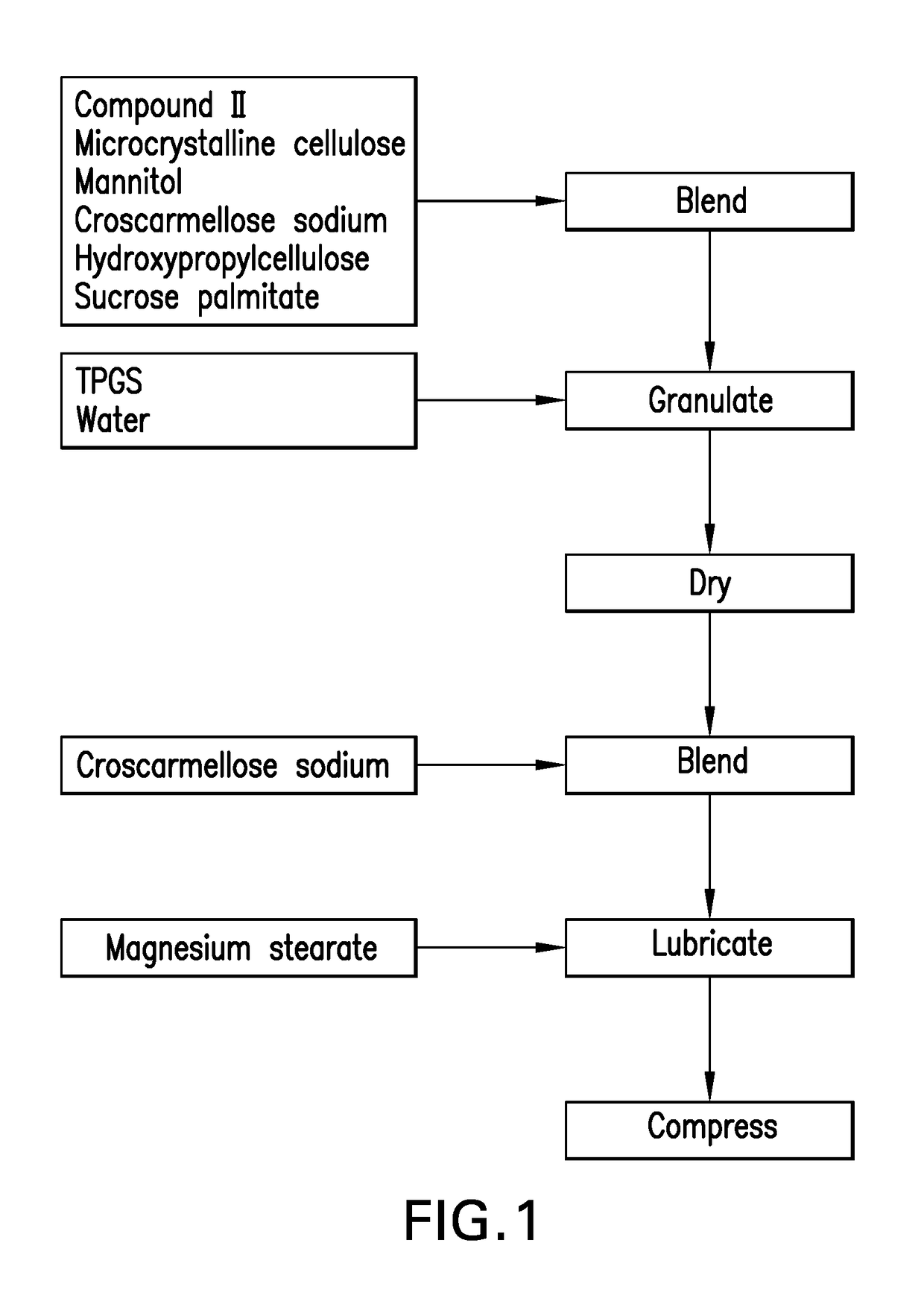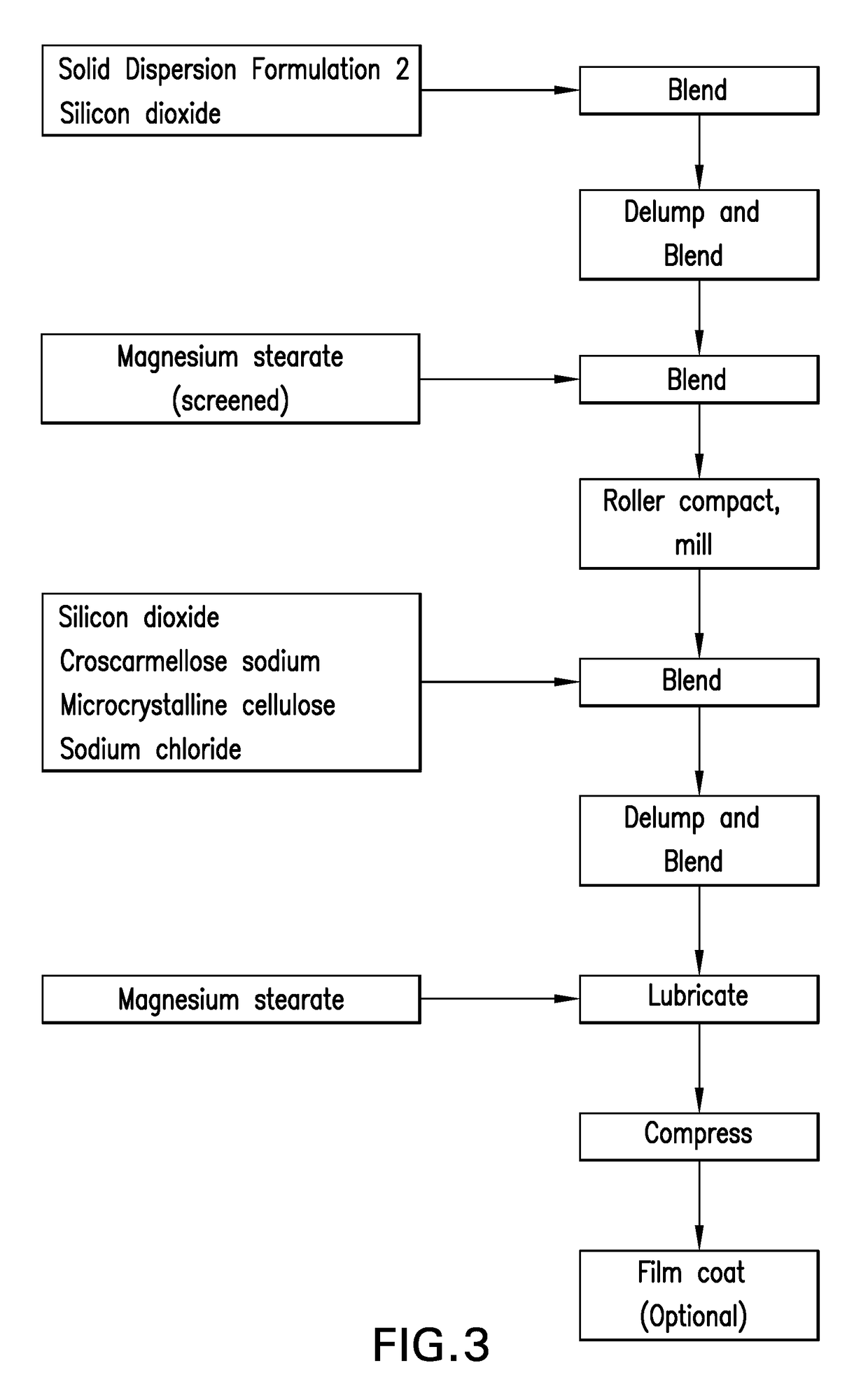Fixed-dose combinations of antiviral compounds
- Summary
- Abstract
- Description
- Claims
- Application Information
AI Technical Summary
Benefits of technology
Problems solved by technology
Method used
Image
Examples
example 1
mpression Tablet Formulation of Compound I
[0165]Compound I may be prepared as disclosed in General Method F of PCT International Patent Application Publication Nos. WO2013 / 177219 and WO2014 / 058801.
[0166]Formulation 1 is a direct-compressed tablet formulation (Table 1) containing 150 mg of Compound I in which crystalline Compound I is combined with microcrystalline cellulose, mannitol, crospovidone and magnesium stearate, and compressed into tablets. To produce the tablets of Formulation 1, Compound I, and the inert excipients, with the exception of the magnesium stearate, were weighed, optionally passed through a screen (Quadro Comil, 610 μm screen, round impeller, 450 rpm) and blended together (3 ft3 V-blender, 250 revolutions). The magnesium stearate was weighed, optionally passed through a screen (No. 30 Mesh) and blended with the other components (3 ft3 V-blender, 50 revolutions). The lubricated blend was then compressed into tablets on a rotary tablet press. The compression par...
example 2
nal Wet-Granulated Formulation of Compound II
[0167]Conventional Formulation 2 is a conventional wet-granulated tablet formulation of Compound II in which Compound II is formulated as a pure amorphous API (Table 2). 60 mg of Compound II is blended with microcrystalline cellulose, mannitol, hydroxypropylcellulose, sucrose palmitate, and a portion of the croscarmellose sodium, added to the bowl of a high-shear granulator, and granulated with a solution of 20% TPGS in water. The resulting granules are dried, milled through a screen with an opening size of approximately 0.8 mm, blended with the remaining croscarmellose sodium, lubricated with the magnesium stearate, and compressed into tablets. The tablet weight was 200 mg using 10 / 32 in standard round concave tooling, and the compression parameters were adjusted to achieve a tablet tensile strength in the range 100-200 MPa. FIG. 1 outlines the process used to make Conventional Formulation 2.
TABLE 2Composition of Conventional Formulation...
example 3
Formulation of Compound II
[0169]Solid Dispersion Formulation 3 is used in a tablet composition, Tablet Formulation 1, containing a solid dispersion of Compound II as shown in Table 4. The solid dispersion was prepared from a solution comprising Compound II, TPGS, and HPMC by spray drying from an acetone / water solvent system, as shown in FIG. 2. The solid dispersion was prepared by spray-drying a solution comprising Compound II, HPMC and TPGS in an acetone / water solvent system. The spray-drying solution was prepared such that it contained 10% solids in solution. This solution was then spray-dried using a NIRO PSD-1 spray dryer with a pressure nozzle to produce the spray-dried particles. The spray-dried particles were flash-dried in a chamber that can contain an inert heated gas (e.g., nitrogen). Heated nitrogen was supplied to the spray dryer at an inlet temperature sufficient to maintain a 40° C. outlet temperature and a gas flow rate of approximately 1850 g / min. The spray drying so...
PUM
| Property | Measurement | Unit |
|---|---|---|
| solubility | aaaaa | aaaaa |
| apparent solubility | aaaaa | aaaaa |
| weight percent | aaaaa | aaaaa |
Abstract
Description
Claims
Application Information
 Login to View More
Login to View More - R&D
- Intellectual Property
- Life Sciences
- Materials
- Tech Scout
- Unparalleled Data Quality
- Higher Quality Content
- 60% Fewer Hallucinations
Browse by: Latest US Patents, China's latest patents, Technical Efficacy Thesaurus, Application Domain, Technology Topic, Popular Technical Reports.
© 2025 PatSnap. All rights reserved.Legal|Privacy policy|Modern Slavery Act Transparency Statement|Sitemap|About US| Contact US: help@patsnap.com



